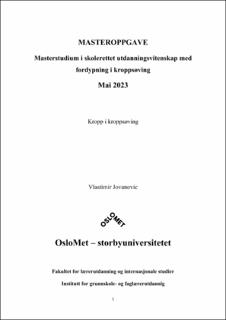| dc.description.abstract | Bakgrunn: Formålet med dette prosjektet er å belyse, diskutere og muligens avdekke ny kunnskap om informantenes plannlegging og gjennomføring av undervisning rundt kompetasemål som omhandler kropp i kroppsøving på ungdommsskolen. Dette er et viktig tema som trenges å settes i søkelys ettersom mange elever på ungdomsskolen opplever kroppspress og er i en aldersperiode der de utvikler seg både fysisk, men også som individer. Generelt sett er mye av den eksisterende forskningen på området rettet mot forholdet mellom kroppsøving og fagets påvirkning på elevenes fysiske kropp og helse, fremfor hvordan kroppsøving kan bidra i utvikling av elevenes kroppsidentiet, selvbilde og forståelse av kropp. Metode: For å fange opp informantenes egne tanker og arbeidspraksis når det gjelder planlegging og gjennomfør av undervisning knyttet til kropp, kroppsidealer, kroppsidentitet og selvbilde ble kvalitativ undersøkelse brukt. Åtte kroppsøvingslærere deltok i studien, og data ble innhentet ved hjelp av individuelle semistrukturerte intervjuer (n=8). Innhentet data ble analysert ved hjelp av tematisk analysemetode. Analysen tok utgangspunkt Braun og Clarke sine seks steg for tematisk analyse, og programmet Nvivo blir brukt som hjelpemiddel i denne prosessen. Resultater: Tre overordnede temaer resulterte fra dataanalysen. Tema 1 (Kropp i kroppsøving ) fremhevet det kroppsperspektivet som informantene er mest opptatte av. Tema 2 (Arbeid med kroppspress i kroppsøving) fremhever ulike arbeidsmetoder som kroppsøvingslærere brukte i arbeide mot kroppspress. Disse inkluderte alt fra samarbeid med andre fag til ulike tilpasninger av ordinær kroppsøvingsundervisning, og bygging av relasjon til eleve. Tema 3 (Planlegging av undervisning) løftet frem hva kroppsøvingslærere fokuserer på når de planlegger for et år, for perioder og for enkelte timer. Dette ga oss informasjon om hvor mye arbeide med kropp som vektlegges i informantenes undervisningspraksis. Konklusjon: Fysisk kropp, tverrfaglig arbeid, målsetting og relasjonsbygging spiller en stor rolle i infromantenes arbeid med kropp i kroppsøvingsundervisning. Samtidig falt fokuset vekk fra selve utfordringen rundt tilrettelegging av undervisning rundt kroppen i ordinær kroppsøvingsundervisning, og alternative arbeidsmetoder ble satt i fokus. Resultatene i studien kan gi kroppsøvingslærere en ide om hvordan de kan jobbe med kropp i praksis. Resultatene antyder også at det er behov for å videreutvikle lærerens kompetanse med å jobbe spesifikt som kompetansemål som omhandler kropp i kroppsøving. På denne måten kan elevene lettere utvikler seg på en måte som definerer deres «jeg», og selvstendig engasjere seg i fysisk aktivitet, fra begynnelsen av ungdomsskolen. På sikt vil dette gi elevene relevante støtteressurser for å hjelpe dem med den vanskelige prosessen de befinner seg i. Samtidig vil det sikte til deres egne ressurser for å fortsette og videre utvikle seg gjennom fysisk aktivitet resten av livet.
Background: The purpose of this project is to elucidate, discuss and possibly uncover new knowledge about the informants' planning and implementation of teaching around competence goals that deal with the body in physical education at secondary school. This is an important topic that needs to be put in the spotlight as many pupils from secondary school experience physical pressure and are in an age period where they develop both physically, but also as individuals. Generally speaking, much of the existing research in the area is aimed at the relationship between physical education and the subject's influence on the pupils' physical bodies and health, rather than how physical education can contribute to the development of the pupils' body identity, self-image and understanding of the body. Method: In order to capture the informants' own thoughts and work practices in terms of planning and carrying out teaching related to the body, body ideals, body identity and self-image, a qualitative research was used. Eight physical education teachers participated in the study, and data was obtained using individual semi-structured interviews (n=8). Collected data was analyzed using the thematic analysis method. The analysis was based on Braun and Clarke's six steps for thematic analysis, and the program Nvivo is used as an aid in this process. Results: Three overarching themes resulted from the data analysis. Theme 1 (Body in physical education) highlighted the body perspective that the informants are most concerned with. Theme 2 (Working with body pressure in physical education) highlights various working methods that physical education teachers used to work against body pressure. These included everything from collaboration with other subjects to various adaptations of ordinary physical education teaching, and building relationships with students. Theme 3 (Planning of teaching) highlighted what physical education teachers focus on when they plan for a year, for periods and for individual lessons. This gave us information about how much work with the body is emphasized in the informants' teaching practice. Conclusion: Physical body, interdisciplinary work, goal setting and relationship building play a major role in the informants' work with the body in physical education teaching. At the same time the focus fell away from the actual challenge of arranging teaching around the body in ordinary physical education teaching, and alternative working methods were put in focus. The results of the study generate implications for practice and suggest that there is a need to further develop the teacher's competence, tailored resources for work with competence targets that deal with the body in physical education teaching at secondary schools. In this way, students can more easily develop in a way that defines their "I", and engage independently in physical activity, from the beginning of secondary school. In turn, this will give students relevant support resources to help with the difficult process they are in, and at the same time address their own resources to continue and further develop through physical activity for the rest of their lives. | en_US |
